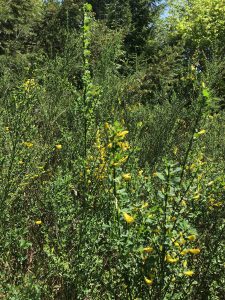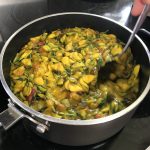After a two week break from my internship with Olympic Yarn and Fiber, we finally got to get back into the swing of things. Today was a beautiful day, so we decided to walk around the property of the farm to see if we couldn’t find something to naturally dye with. Lynn has a PHD in chemistry, so it was very helpful to hear her explain the science behind natural dyes.
However, before doing that, we surveyed the back pasture on the farm to see if it was ready to let the herd of male alpaca graze in. We checked to see if there was enough grass to make it worth it and also looked to see if there were any plants that could potentially be harmful to the animals. We did come across one plant called tansy ragwort that can kill most livestock if ingested. I learned that there is a moth called the tansy moth whose larvae live on and destroy tansy ragwort, so if a moth is found on one it is actually best to leave the plant in tact in order to encourage the survival of the beneficial insect.

While walking, we noticed that the Scotch Broom on the property was flowering. Scotch Broom is incredibly invasive here in Washington, so we decided to see if we couldn’t find a use for it since the plant is everywhere anyway. We picked the flowers and branches and separated the two so we could discern where the color (if any) would come from. Then, boiled some water with vinegar to use as a fixative.
First, we added the flowers to the boiling water since we had a feeling that they would have the least amount of color in them. We turned out to be right since an hour of boiling yielded only the slightest yellow shade. We then added the branches to the mixture and saw that the color of the water darkened noticeably. We also decided to create a second dye bath out of red wine so that I could get an idea of the difference between a heavily pigmented and fermented dye and a freshly picked, lighter material.
We dyed one skein of light gray sheep’s wool in the Scotch Broom mixture, and one in the red wine as well as a sample of white merino wool to get an idea of the true color of the dye. While we waited for it to soak, we went over some samples of dyes that Lynn uses for her own yarn collection and I learned a bit more about the dying process. I learned that sheep wool tends to take color more readily than alpaca fiber due to their structure, so lighter dyes tend not to even be worth trying when it comes to the later. I also learned that different mordants tend to yield vastly different colors because they alter which aspects of the dye materials hold to the fiber.
After an hour or so of soaking, we checked on the samples and found that the red wine dyed yarn took very quickly, and the Scotch Broom only yielded a very pale yellow color. It wasn’t all that surprising since we expected that if there were a truly significant use for the plant, somebody probably would have figured it out by now, but it was still fun to experiment with it! The yarn is currently drying, so next week week I will be able to take a photo of the finished product.

Next week we are going to be working on carding for a client who would like their wool to be processed into roving, so I am excited to be working with more machinery.




